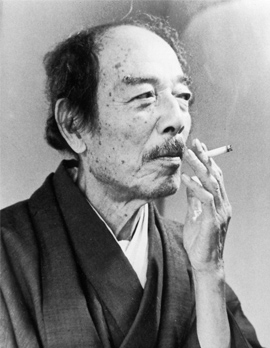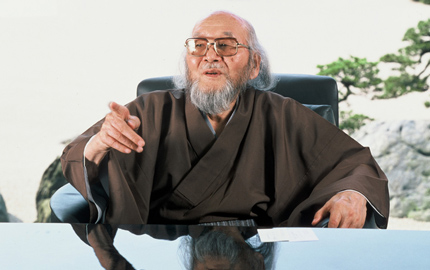
Yokoyama Taikan and Adachi Zenko

Yokoyama Taikan
In his autobiography, Adachi wrote:
“I hear the Adachi Museum of Art sometimes referred to as the ‘Taikan Museum of Art.’ This maybe because the masterpieces of Yokoyama Taikan are a glorious achievement in modern Japanese painting, and his works are in a great many collections. The core of the Adachi collection is certainly modern Japanese paintings, but it is Taikan who stands out in terms of quantity and quality. The recognition he has earned is for me justification of a long-held personal belief in his greatness. In short, it is Taikan’s ideation and expression that make his art so wonderful and inimitable. His engagement in life’s challenges with energy and a truth-seeking spirit give his works power, depth, and compositional integrity. People say that such a painter comes along only once every 100 years, or even 300 years. It is strange indeed that a dropout like myself feels so strong a connection to so great a painter! In terms of disposition and preparedness toward life, nothing would make me happier than to resemble him even in the slightest.”
With great vigor, Taikan almost singlehandedly revived the Japan Art Institute, producing one masterpiece after another, year after year. At the age of 14 or 15, Adachi hauled a cart through the snow wearing only flimsy straw sandals, later emerging from these humble beginnings to become the largest owner of Taikan’s paintings in Japan. Perhaps the two had much in common beyond the obvious hardships they faced. Innovative ways of thinking, deep creativity and natural dynamism: in these ways perhaps they were similar.
For example, Taikan revolutionized the Japanese art world by developing a painting technique called karabake brushing paint dripped on a wet surface with a dry brush. Adachi, claiming to have no knowledge of the management of museums, devised a groundbreaking way to operate the museum such that it attracts more than 500,000 visitors annually, making it one of Japan’s leading museums in terms of visitor numbers.
Neither was bound by convention, and the two men were kindred spirits in their free thinking. One can also see their expanse of vision in the great breadth of Taikan’s works and the inexhaustible diversity of Adachi’s ideas.
However imposing and serious he may have been, Taikan always had the courtesy to see to the door young picture framers who worked with him, even when he could barely stand up after a night of drinking. For all the single-minded drive of Adachi, he had the humility to ask the people around him, some so young they could have been his grandchildren, for their opinions.
No matter how busy, he would make notes the day before for an interview of just a few lines in a local newspaper. He would banter with reporters and make them feel welcome, afterwards collapsing with exhaustion. The two men had such thoroughness in common.
Morning and evening Adachi would view his garden, and if anything appeared odd, however small, the gardener would be called in. Always the hands-on type, he had such fervor for art.

Adachi Zenko in his later years
Once he talked about a painting he had failed to acquire, saying “Coming into contact with a masterpiece is just like meeting a person. It is fate. Collecting paintings is not about money. It is not about price. When a great painting is up for sale, you should close your eyes and grab it. I feel really bad about that painting. Even now I sometimes wake up at night with a start, remembering it, and then can’t fall sleep again.”
Zenko’s Dream and Ambition
Adachi Zenko passed away in 1990 at the age of 91, carrying to his ultimate twilight the fulfillment of his dream of presenting the Adachi Museum of Art to the world. When I recall his passion, one realizes that it is not just the paintings or the garden or even the people that Adachi wanted us to encounter at the museum. It is his wish for the touching of our hearts by the beauty that permeates every corner of the Adachi Museum of Art. For every visitor to take in the beauty and be moved by it was the founder’s simple wish in establishing this art museum.


